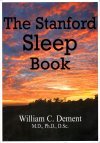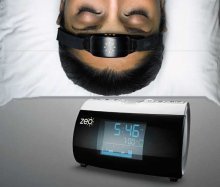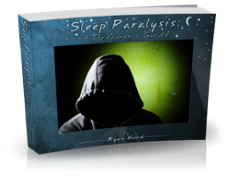
| Connect & Subscribe |
Sleeping is the Most Productive Part of Your Day
An Outreach Project by Nicole DeMont | Return To Outreach Projects 2010
If you have ever pulled an all-nighter, you know how hard it is to stay awake the next day. What causes this overwhelming feeling of drowsiness? The answer lies in sleep debt.
Getting enough sleep is a problem for high school students as well as college students. Extra-curricular activities, homework, friends, and family do not leave students with enough time to get a full night's sleep. Most students sacrifice hours of sleep without realizing the negative effects this decision has on their everyday lives.
The lack of knowledge concerning sleep, sleep debt and sleep disorders is the reason that Dr. William Dement M.D., Ph.D., D.Sc. has taught the Sleep and Dreams course at Stanford University since 1970.
Dr. Dement is the world's leading sleep expert and the author of The Stanford Sleep book, now in its fifth edition. He founded the American Academy of Sleep Medicine, the American Board of Sleep Medicine, and served as chairman of the U.S. Congress's National Commission on Sleep Disorders Research.
His main motivation for continuing the class for 40 years and publishing hundreds of articles and numerous books is to educate people on the dangers of sleep deprivation.
Studies have proven that drowsy driving is more dangerous than drunk driving. In 1986 Malcolm Parsons conducted a study that found that 87% of motor vehicle accidents caused by falling asleep at the wheel are fatal, with each accident averaging 2.89 deaths.
Sleep deprivation seeps into other areas of students' lives as well. A large sleep debt will make it difficult to wake up in the morning and pay attention in class. A student with a small sleep debt will be motivated and energized, make fewer errors, and perform better athletically and academically.
Every night a person does not get the necessary hours of sleep, the lost sleep becomes sleep debt. Sleep debt accumulates night after night, and the only way to reduce sleep debt is to get extra sleep.
Often when people sleep more hours than usual, perhaps 12 hours, and continue to feel drowsy the next day, they mistakenly believe that the extra sleep made them drowsier. They decide not to sleep as long in the future, but this conclusion is false.
On the contrary, people who continue to feel drowsy after many hours of sleep need to sleep more. Their drowsiness is an indicator of a large sleep debt that has not been fully reduced.
A larger sleep debt increases the tendency to fall asleep. Sleep latency is the amount of time it takes a person to go from wakefulness to sleep. The Multiple Sleep Latency Test measures the strength of daytime sleep tendency. To perform the test, a person lies in bed every two hours and tries to fall asleep. Shorter sleep latency signifies a greater sleep tendency and is related to decreasing ability to perform daytime tasks. Longer sleep latency signifies a lesser sleep tendency.
Each person requires a different amount of sleep each night to achieve optimal alertness during the day. By simply taking a moment every few hours to assess how drowsy or alert one feels can help determine individual sleep need.
The person must commit to sleeping on a regular schedule for consecutive weeks, which can be difficult for a teenager with a busy schedule.
Nevertheless, if the person sleeps for eight hours per night for consecutive weeks and still feels drowsy during the day, then he or she requires more than eight hours.
If the person sleeps for eight hours consecutively and has trouble falling sleep at night or begins to wake up too early in the morning, then the individual does not require eight hours of sleep.
By continuing this experiment for several weeks, a person can determine his or her exact sleep requirement.
Anyone who has the privilege of hearing one of Dr. Dement's lectures will leave with his mantra locked in their mind forever: "Drowsiness is red alert!" Almost every Stanford student, even those who have not taken the Sleep and Dreams course, knows that phrase.
Dr. Dement wants students to remember the detrimental effects of sleep deprivation - mainly that drowsy driving puts lives in danger. But the mantra also reminds students that drowsiness impairs memory, focus, mood, appetite and almost every part of daily life.
Never underestimate the power of sleep. Even though sleeping prevents you from doing other activities, it is undoubtedly the most productive part of your day.
Nicole DeMont, a FSHA graduate of the class of 2009, is a freshman at Stanford University
Tolog Sleep Survey
A sleep survey was given to 28 Tologs on Feb. 3, 2010. Their answers to selected questions are as follows:
- 1. Have you ever driven when you have felt drowsy? 77% said yes
- 2. Have you ever had to consciously keep yourself awake in class? 92% said yes
- 3. Have you ever fallen asleep in class? 71% said yes
- 4. How many hours of sleep do you get on a typical school night? 64% said 5-6 hrs.
- 5. How often do you have trouble waking up in the morning? 82% said always
- 6. How often do you feel tired during the day? 48% said always
A large sleep debt will make it difficult to pay attention in class. A student with a small sleep debt will be motivated and energized, make fewer errors, and perform better athletically and academically.
Return To Outreach Projects 2010
Go from Sleeping is the Most Productive Part of Your Day to Important Info on Sleep Debt
About This Site
Welcome! This site is continuously being created by students of Dr. William C. Dement's Sleep And Dreams course at Stanford University.
We made this site as a call to action for people all over the world to live healthier, happier, safer, and more productive lives by learning about their own sleep. We have faith that reading the information provided on this site will motivate you to be smart about your sleep deprivation and strategic about your alertness in order to live life to your fullest, most energetic potential.
In fact, we challenge you to do so! What do you say, are you up for the challenge?
Interviews With Sleep Specialists: Insights Into the Worlds of Sleep Medicine & Sleep Business
America's Most Dangerous Disorder: What Is Sleep Apnea Doing To Your Sleep?
Sleep Debt: How Much More Will You Achieve When You Reduce Yours?
The Stages Of Sleep: The Journey Through The Night
Delayed Sleep Phase: You Want To Sleep But You're Not Tired Yet
Paralyzed at Night: Is Sleep Paralysis Normal?
Sleep In Words: Smart, Strange, and Funny Quotes About Sleep
Sleep Disorders In Children: What's Keeping Your Child From A Full Night's Rest?
Attacks of Pavor Nocturnus (a.k.a. Sleep Terrors, Night Terrors, or Incubus Attacks)
The Stanford Sleep Book
Dr. Dement's pioneering textbook has been the core text for Sleep and Dreams since 1980, but it has just recently been made available to the wider public for the first time.
In it you'll find a more detailed account of the most important things you need to know about sleep, alertness, dreams, and sleep disorders. Studies, statistics, plus plenty of Dr. Dement's classic anecdotes painting the history of sleep medicine.
Preface | Intro | Contents | Get A Copy
More Sleep Resources
The Zeo
A revolution in personal sleep tracking, the Zeo is a wireless headband that transmits your brainwaves in realtime to a dock (pictured here) or your smartphone. The result? You can wake up and see exactly what stages of sleep you were in during the night! Unprecedented personalized sleep knowledge.
Sleep Paralysis: A Dreamer's Guide
Ever woken up paralyzed? A surprising number of us have, believe it or not. But few know the actual causes of this phenomenon, and fewer still how to exert control over it. Dream researcher and sleep paralysis expert Ryan Hurd shares breakthrough insights into how to do just that.
Important Disclaimer
Please Note:
The information found on this page and throughout this site is intended for general information purposes only. While it may prove useful and empowering, it is NOT intended as a substitute for the expertise and judgments of healthcare practitioners.
For more info, see our
Terms of Use.









